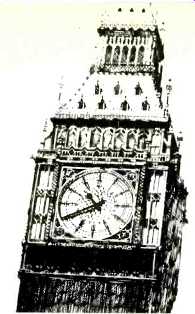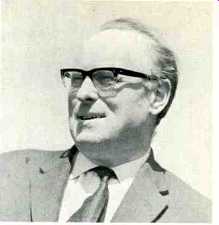

Donald Aldous is a well-known British authority on Hi-Fi. He is Technical Editor of Record Review and an Editor of Hi-Fi News.
By way of introduction to this first newsletter from England, may I offer a sort of critic's credo? I believe that sound recording and reproduction has come a long way towards the goal of perfection--whatever that means in this connotation--since I started writing about the subject in 1934, but today even with so-called "state-of-the-art" systems, we still have a long way to go to achieve that pinnacle of fidelity. I have brooded long and hard on the subtleties of music reproduction, whether its purpose is to bring the performers into the listeners' homes or should the listeners be transported into the concert hall environment? So we come into the areas of spatial, ambient, and stereophonic perception, leading on to the aesthetics of listening, touching on the psychology--indeed, some say the psycho-pathology--of the hi-fi addict! I have peered into the ceramic ball--the crystal ball is outmoded--and I am not appalled by what I have seen for the audiophile and music lover of the future. Some enthusiasts may still be listening to the music to hear the loudspeakers, whilst others tolerate the loudspeakers to hear the music, to paraphrase Peter "Quad" Walker, but the expanding availability of simple high quality methods (tapes, cassettes, cartridges, disks, and the latest electronic techniques enveloping video, in addition to audio programs) is not anathema to me, as it appears to be to some old school musical purists.
I agree with John Culshaw ( formerly Decca Record Company producer, now Head of Music, BBC Television ), as he says in his book, Ring Resounding, "Mass communication by means of records and television and radio does not, as some Jeremiahs predict, necessarily mean a lowering of standards; on the contrary, over a long enough period, standards are bound to rise. The better is still the enemy of the good, and the general accessibility of art in all forms is a fine thing, even in its unconscious effect on those who profess to have no interest in it." Sound should make love to one's ears, as a Swedish friend remarked to me years ago, and this sonic enchantment remains with me, despite the subject being a profession. If that magic ever dies, I shall give it up--and stop eating!
---
Talking of Sweden reminds me that I had the pleasure recently, with a few other technical journalists, to go over to Stockholm to get a briefing firsthand on the plans of the Sonab organization to launch a range of loudspeakers and allied equipment in the hi-fi world.
Guided by the executive director of the new British company, Sonab Ltd. Derek Cheney ( formerly with Bang & Olufsen and Hanimex ( Toshiba Division) in UK); we were intrigued to learn that the organization is now fully Government owned, and is a subsidiary of Stratsforetag AB, a huge nationalized group of 24 different companies, having many interests in forestry, pharmaceuticals, shipbuilding, chemical, mechanical and electronic engineering. The share capital of the group is around SKr: 1,700 million ( $340 millions) and, at present, the Sonab hi-fi equipment are the only "nationalized" consumer products, as all the other items are made for commerce or industry. Sonab GmbH. in Dusseldorf, West Germany, has also been established recently, with Hans Wagner, as the overall President. We met Mr. Wagner during our tour and if dynamism and forward-thinking produces success, this new Sonab project will help the company attain its 1975 target of a turnover figure of about 19 million dollars. This expanded program, of course, covers the whole field of communications, not merely hi-fi, and it is planned to recruit 45 development engineers by the end of 1970.
All the Sonab loudspeakers are in the upper price bracket and, with one exception, employ a multi -unit array mounted to radiate upward and outward omni-directionally. The enclosures are of the bass reflex type, and the most expensive model-which will sell in UK for the equivalent of some $380-for which it is claimed that "no other speaker, only the original sound itself, can compete." Six units are fitted, comprising an 831 in. bass driver and an 831 in. wide-range mid-register unit ( both made by Philips ) and four 2 in. tweeters.
The other items from Sonab include an advanced FM tuner-amplifier and a sophisticated record turntable unit. The tuner-amplifier R.7000 delivers 35 W rms per channel into 8 ohms, with harmonic distortion, at 1 kHz less than 0.02% at 8 ohms. Tuner section sensitivity is 1.4 µV (DIN) and 1.5 µV (IHF). Features include rumble filter (5 dB at 100 Hz) and three h.f. filters. The turntable unit, 70S, is operated by only two buttons, and is powered by a four pole synchronous two -speed motor, through a belt drive. The pickup arm is mounted on a ball -bearing and is claimed to be completely free from "torsion resonance." A Shure M75MG type II cartridge is fitted. These products are manufactured in Japan, by Yamaha, to Sonab specifications.
---
Audio fairs, festivals, exhibitions, and other gatherings of the audio clans are proliferating in the UK. We had one show in Manchester lately at which musical instruments, sound amplification, and "pop" groups were assembled under one roof, culminating in a cacophonous bedlam and a sharp rise in sale of aspirins and ear -plugs. Apart from the long-established Audio Fairs (organized by Cyril Rex -Hassan ), the 1970 version of which will be held in the large [...] Olympia hall from October 19th (trade day) to 24th, a successful audio show, called Sonex '70, was staged a few months ago at the Skyway Hotel, adjacent to London Airport. This is not a ridiculous site, as the sound-proofing of the rooms made listening conditions acceptable, although accommodation of not more than 12 to 14 people was the maximum possible. Acoustic Research's first British demonstration of four -channel stereo, variously known as "quadraphonic" or "quadrosonic," mounted by Bell & Howell's representatives, led by Manager Denis Wratten and Martin Borish (AR, in USA) attracted tremendous interest, not all favorable, but the system has a future, I think, when tastefully used. Seating position in relation to the four loudspeakers is important, even critical, but the effect of being immersed in sound-particularly on audience applause-and the simulation of the concert hall environment I found most impressive.
Loudspeakers continue to attract designers, and many types and sizes of reproducer were seen and heard at this show. John Wright's Monitor and Studio models, employing the "transmission line" principles, originated by Arthur Radford and Dr. Bailey, although in his own manner in the Transmission Electronics Company speakers. Irving "Bud" Fried is handling this product in the USA, with other top -grade British audio items. Yet another loudspeaker, incorporating the acoustic transmission line approach, has been developed by Bert Webb for Cambridge Audio. This has an i.f. driver in damped tapered labyrinth, and the h.f. driver in a damped tapered pipe, plus two pressure h.f. drive units.
Frequency range from 25 Hz to 25 kHz with crossover frequencies at 400 Hz, 3 kHz and 10 kHz.
Quad ( Acoustical) remain the only firm here manufacturing a full-range electrostatic loudspeaker, and rumours are streng that a Mk.II version is under development, but no release date known.
A trend would seem to be the marketing of do-it-yourself loudspeaker assembly kits, which offer the advantages of reducing packing and transport costs, and the cabinet finish can be in any preferred styling. Firms offering these kits in England are KEF, EMI, Heathkit (Daystrom), Wharfedale, and Richard Allan.
Rola-Celestion produce three loudspeakers, with the two bigger models, Ditton 15 and 25 having an auxiliary bass radiator (ABR) that helps to produce a most pleasing sound. Donald Chave (Lowther) demonstrated his new "Auditorium" sound, a combined forward/rearward speaker system that certainly locates the sound within a frame, as it were.
Rogers Developments had a demonstration in which their new Ravensbrook 3 -speaker system was fed from a single Ravensbrook stereo amplifier or six such amplifiers connected in cascade. This illustrated the high performance of the overall system and confirmed the fact that transformer coupling in these models does not impair performance. With six amplifiers, the signal is amplified through twelve transformers, but virtually no audible quality change was apparent, with a switchover from the single channel.
Cambridge Audio is part of an electronics' group that has created a remarkable amplifier, model P.4D, which has an exceptional input overload characteristic that cannot, in fact, be overloaded by any known recording. Mr. J. E. Sugden has another unconventional amplifier design which employs a Class A output stage, which means lower efficiency, but the distortion is reduced as the volume level drops.
FM tuners abound here (covering the range 88-108 MHz) with variable or pre-set tuning, although the big influx of models from Germany, Denmark, Japan, and the USA leaves little scope for the indigenous designer, unless he can develop a model suitable for an overseas market. This means creating a high -sensitivity and -selectivity circuit, with many pre-set buttons ( the UK has only three groups of FM/VHF transmissions), and finding a style of presentation acceptable to a world-wide market. We saw the Leak "Stereofetic," the Rogers Ravens brook, and a model from J. E. Sugden, as well as a very sophisticated prototype from Cambridge Audio. Still only in the laboratory stage, it is a "tracking filter" design, a phase-sensitive system, with a signal -amplitude display that simplifies aerial alignment and signal selection. The r.f. gain control gives good linearity in areas of high local -station interference.
The unit has AOS (acquisition of signal) and stereo transmission lights to simplify accurate tuning. It is said that later models (when and if actually produced) will include an optional digital clock station selector, and digital read-out of frequency to eliminate tuning -dial errors.
This unit will be expensive, perhaps more than $240. Although not actually exhibiting at this Sonex '70 exhibition, we did meet our old friend Alec Rangabe, designer of the Trutrack radial arm (with mercury contact float chamber which he has high hopes will be marketed this year. More news soon.
-D.A.
(Audio magazine, Sept 1970)
Also see:
London Letter: Edison Updated, Awards Reinstated (May 1985)
From the people who brought you Franz Liszt? (Apr. 1972)
= = = =